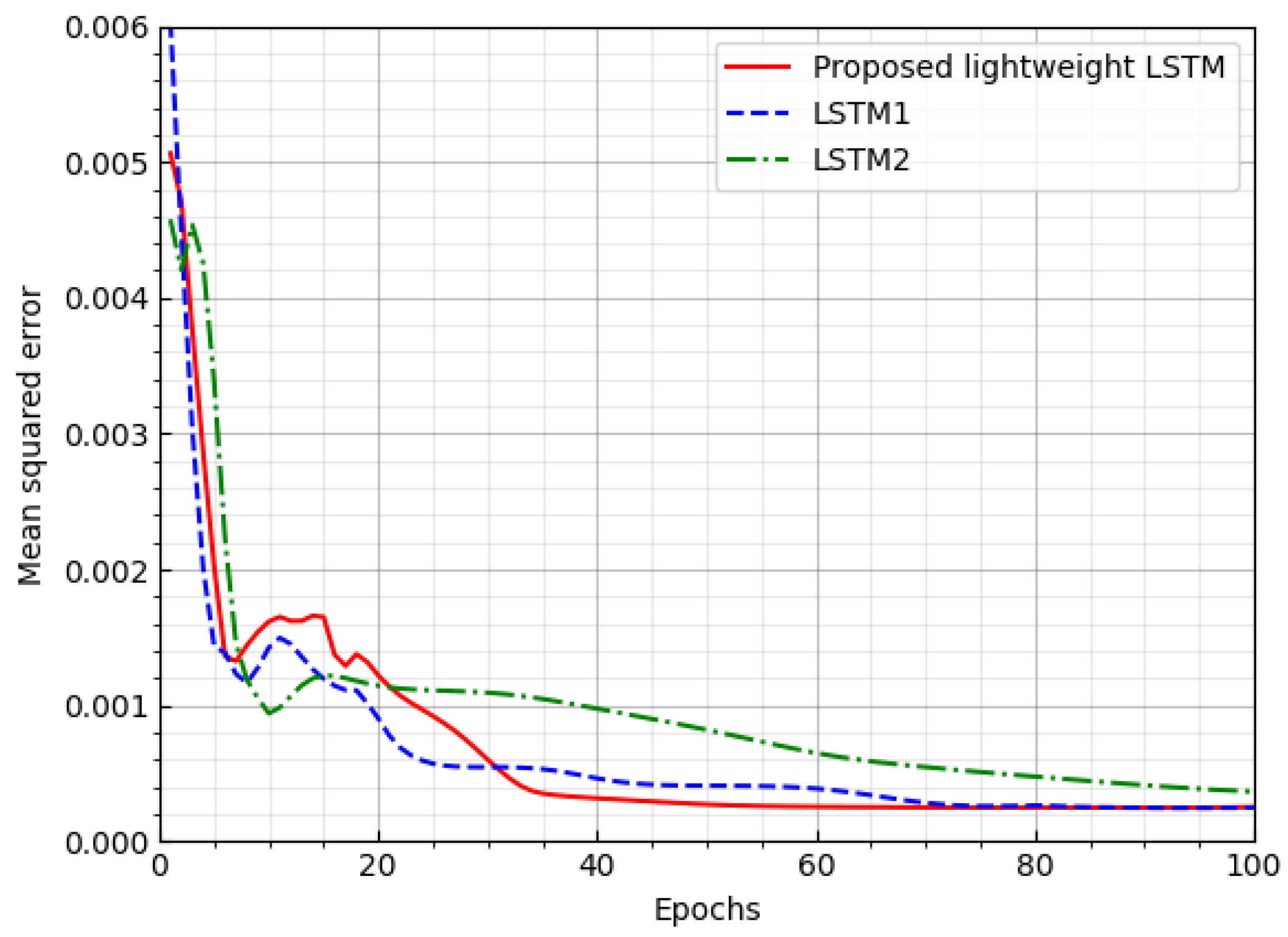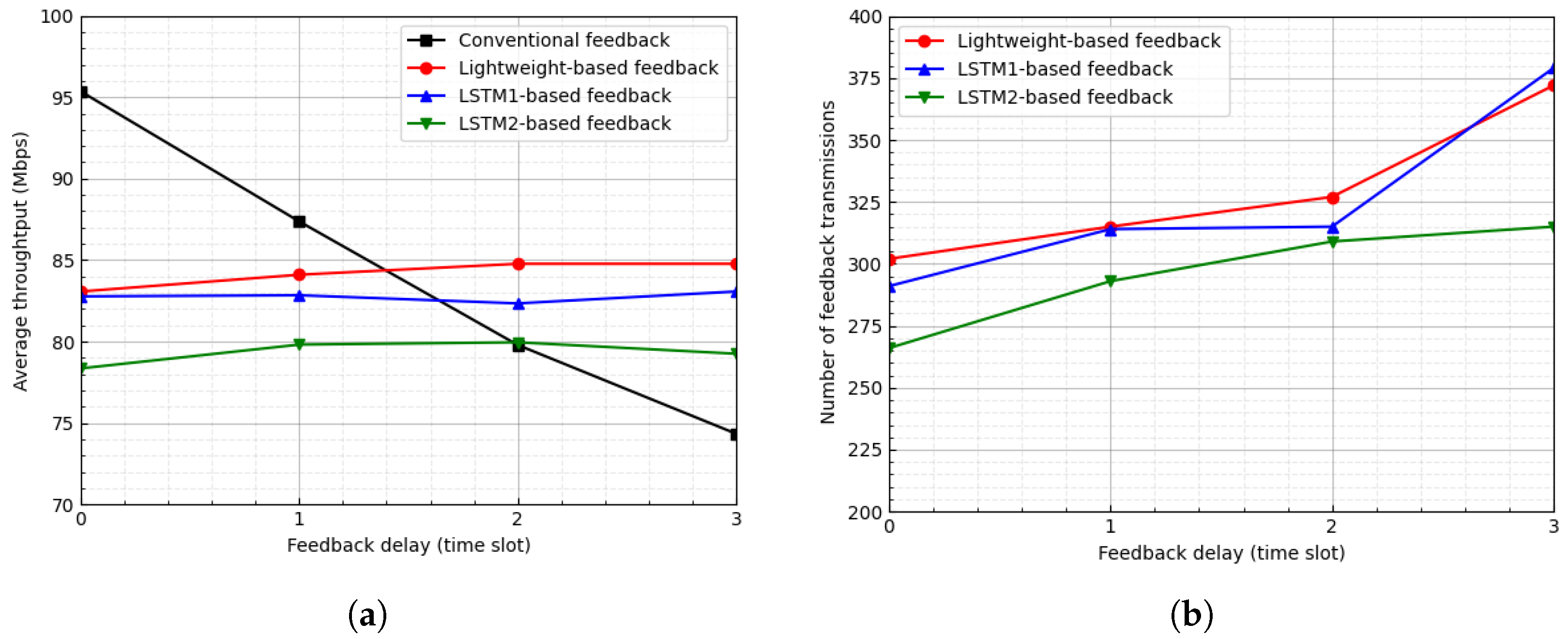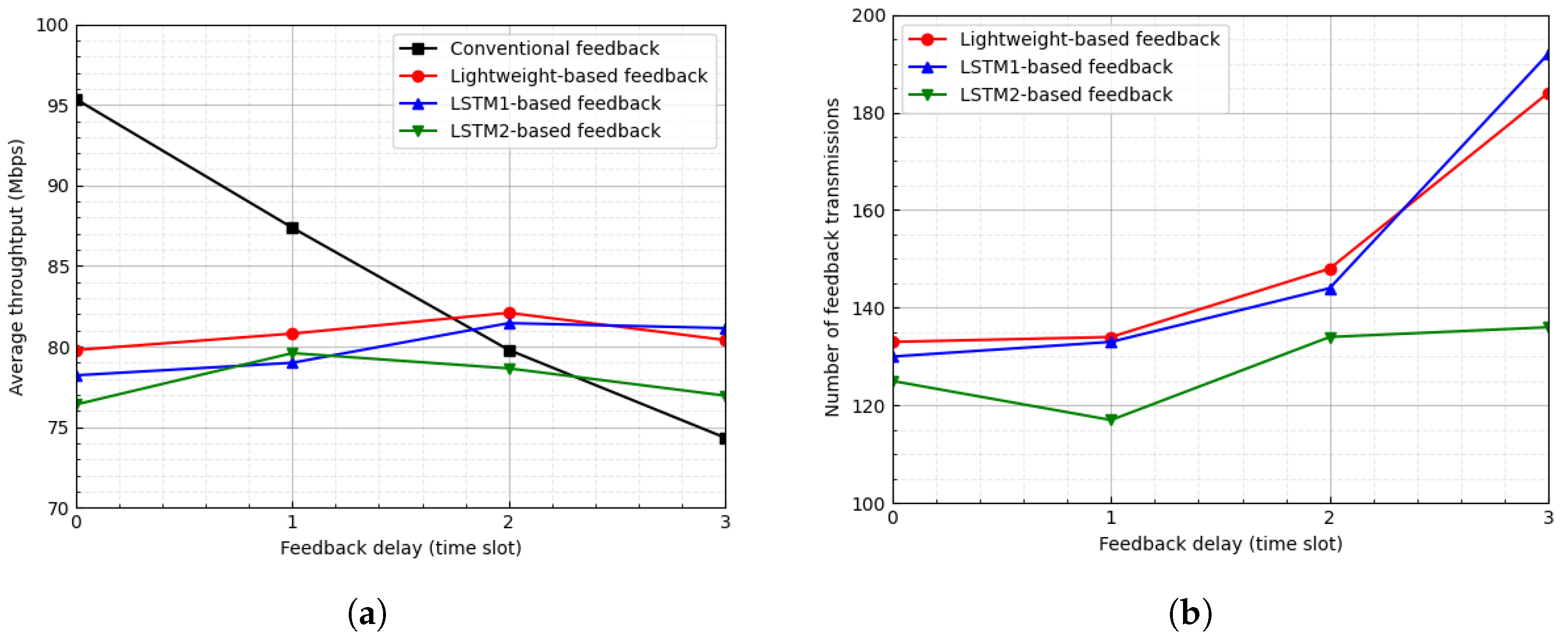Lightweight LSTM-Based Adaptive CQI Feedback Scheme for IoT Devices
Abstract
1. Introduction
2. System Model
2.1. Channel Model
2.2. Adaptive Modulation and Coding Scheme
3. Proposed Lightweight LSTM-Based CQI Feedback
3.1. Proposed Lightweight LSTM Model
3.2. Proposed LSTM-Based Aperiodic CQI Feedback
| Algorithm 1 Lightweight LSTM-based adaptive CQI feedback. |
|
4. Results and Discussions
4.1. Performance of Lightweight LSTM
4.2. Performance of Lightweight LSTM-Based CSI Feedback
5. Conclusions
Author Contributions
Funding
Data Availability Statement
Conflicts of Interest
References
- McKinsey. The Accelerating Value of the Internet of Things. 2022. Available online: https://www.mckinsey.com/alumni/news-and-events/global-news/firm-news/the-accelerating-value-of-the-internet-of-thing (accessed on 26 December 2022).
- Balieiro, A.; Dias, K.; Guarda, P. A machine learning approach for CQI feedback delay in 5G and beyond 5G networks. In Proceedings of the 2021 Wireless and Optical Communications Conference (WOCC), Taipei, Taiwan, 7–8 October 2021; pp. 26–30. [Google Scholar]
- 3GPP. 3rd Generation Partnership Project; Technical Specification Group Radio Access Network; NR; Physical Layer Procedures for Data (Release 17); Version 17.3.0; Technical Report (TR) 38.214; 3rd Generation Partnership Project (3GPP): Valbonne, France, 2022. [Google Scholar]
- Chou, E.S.; Kahn, J.M. Adaptive coding and modulation for robust optical access networks. J. Light. Technol. 2020, 38, 2242–2252. [Google Scholar] [CrossRef]
- Xue, R.; Yu, H.; Cheng, Q. Adaptive coded modulation based on continuous phase modulation for inter-satellite links of global navigation satellite systems. IEEE Access 2018, 6, 20652–20662. [Google Scholar] [CrossRef]
- Elzanaty, A.; Alouini, M.S. Adaptive coded modulation for IM/DD free-space optical backhauling: A probabilistic shaping approach. IEEE Trans. Commun. 2020, 68, 6388–6402. [Google Scholar] [CrossRef]
- Mamat, K.; Santipach, W. On optimizing feedback interval for temporally correlated MIMO channels with transmit beamforming and finite-rate feedback. IEEE Trans. Commun. 2018, 66, 3407–3419. [Google Scholar] [CrossRef]
- Zhang, F.; Chen, J.; Mao, T.; Wang, Z. Feedback interval optimization for MISO LiFi systems. IEEE Access 2021, 9, 136811–136818. [Google Scholar] [CrossRef]
- Mukherjee, P.; De, S. Dynamic feedback-based adaptive modulation for energy-efficient communication. IEEE Commun. Lett. 2019, 23, 946–949. [Google Scholar] [CrossRef]
- 3GPP. 3rd Generation Partnership Project; Technical Specification Group Radio Access Network; Study on Artificial Intelligence (AI)/Machine Learning (ML) for NR Air Interface (Release 18); Version 0.0.0; Technical Report (TR) 38.843; 3rd Generation Partnership Project (3GPP): Valbonne, France, 2022. [Google Scholar]
- Wen, C.K.; Shih, W.T.; Jin, S. Deep learning for massive MIMO CSI feedback. IEEE Wirel. Commun. Lett. 2018, 7, 748–751. [Google Scholar] [CrossRef]
- Lu, Z.; Wang, J.; Song, J. Multi-resolution CSI feedback with deep learning in massive MIMO system. In Proceedings of the IEEE International Conference Commun. (ICC), Dublin, Ireland, 7–11 June 2020; pp. 1–6. [Google Scholar]
- Guo, J.; Wen, C.-K.; Jin, S.; Li, G.Y. Convolutional neural network-based multiple-rate compressive sensing for massive MIMO CSI feedback: Design, simulation, and analysis. IEEE Trans. Wirel. Commun. 2020, 19, 2827–2840. [Google Scholar] [CrossRef]
- Jang, Y.; Kong, G.; Jung, M.; Choi, S.; Kim, I. Deep autoencoder based CSI feedback with feedback errors and feedback delay in FDD massive MIMO systems. IEEE Wirel. Commun. Lett. 2019, 8, 833–836. [Google Scholar] [CrossRef]
- Guo, J.; Wen, C.-K.; Jin, S.; Li, G.Y. Overview of deep learning-based CSI feedback massive MIMO systems. IEEE Trans. Commun. 2022, 70, 8017–8045. [Google Scholar] [CrossRef]
- Hussien, M.; Nguyen, K.K.; Cheriet, M. PRVNet: Variational autoencoders for massive MIMO CSI feedback. arXiv 2022, arXiv:2011.04178v2. [Google Scholar]
- Sun, Y.; Xu, W.; Liang, L.; Wang, N.; Li, G.Y.; You, X. A lightweight deep network for efficient CSI feedback in massive MIMO systems. IEEE Wirel. Commun. Lett. 2021, 10, 1840–1844. [Google Scholar] [CrossRef]
- Ji, S.; Li, M. CLNet: Complex input lightweight neural network designed for massive MIMO CSI feedback. IEEE Wirel. Commun. Lett. 2021, 10, 2318–2322. [Google Scholar] [CrossRef]
- Cao, Z.; Shih, W.T.; Guo, J.; Wen, C.K.; Jin, S. Lightweight convolutional neural networks for CSI feedback in massive MIMO. IEEE Commun. Lett. 2021, 8, 2624–2628. [Google Scholar] [CrossRef]
- Jo, S.; So, J. Adaptive lightweight CNN-based CSI feedback for massive MIMO systems. IEEE Wirel. Commun. Lett. 2021, 10, 2776–2780. [Google Scholar] [CrossRef]
- Li, H.; Zhang, B.; Chang, H.; Liang, X.; Gu, X. CVLNet: A complex-valued lightweight network for CSI feedback. IEEE Wirel. Commun. Lett. 2022, 11, 1092–1096. [Google Scholar] [CrossRef]
- Wang, T.; Wen, C.K.; Jin, S.; Li, G.Y. Deep learning-based CSI feedback approach for time-varying massive MIMO channels. IEEE Wirel. Commun. Lett. 2019, 8, 416–419. [Google Scholar] [CrossRef]
- Lu, C.; Xu, W.; Shen, H.; Zhu, J.; Wang, K. MIMO channel information feedback using deep recurrent network. IEEE Commun. Lett. 2019, 23, 188–191. [Google Scholar] [CrossRef]
- Liao, Y.; Yao, H.; Hua, Y.; Li, C. CSI feedback based on deep learning for massive MIMO systems. IEEE Access 2019, 7, 86810–86820. [Google Scholar] [CrossRef]
- Zhang, Z.; Zheng, Y.; Gan, C.; Zhu, Q. Massive MIMO CSI reconstruction using CNN-LSTM and attention mechanism. IET Commun. 2020, 14, 3089–3094. [Google Scholar] [CrossRef]
- Li, X.; Wu, H. Spatio-temporal representation with deep neural recurrent network in MIMO CSI feedback. IEEE Wirel. Commun. Lett. 2020, 9, 653–657. [Google Scholar] [CrossRef]
- Li, Q.; Zhang, A.; Liu, P.; Li, J.; Li, C. A novel CSI feedback approach for massive MIMO using LSTM-attention CNN. IEEE Access 2020, 8, 7295–7302. [Google Scholar] [CrossRef]
- Liu, Z.; del Rosario, M.; Ding, Z. A Markovian model-driven deep learning framework for massive MIMO CSI feedback. IEEE Trans. Wirel. Commun. 2022, 21, 1214–1228. [Google Scholar] [CrossRef]
- Guo, J.; Yang, X.; Wen, C.K.; Jin, S.; Li, G.Y. Deep learning-based CSI feedback and cooperative recovery in massive MIMO. arXiv 2022, arXiv:2003.03303. [Google Scholar]
- Wang, X.; Li, H.; Wu, Q. Optimizing adaptive coding and modulation for satellite network with ML-based CSI prediction. In Proceedings of the 2019 the IEEE Wireless Communications and Networking Conference (WCNC), Marrakesh, Morocco, 15–18 April 2019; pp. 1–6. [Google Scholar]
- Mashhadi, S.; Ghiasi, N.; Farahmand, S.; Razavizadeh, S.M. Deep reinforcement learning based adaptive modulation with outdated CSI. IEEE Wirel. Commun. Lett. 2021, 25, 3291–3295. [Google Scholar] [CrossRef]
- Zhang, Y.; Zhu, J.; Wang, H.; Shen, X.; Wang, B.; Dong, Y. Deep reinforcement learning-based adaptive modulation for underwater acoustic communication with outdated channel state information. Remote Sens. 2022, 14, 3947. [Google Scholar] [CrossRef]
- Hong, S.; So, J. Machine learning-based adaptive CSI feedback interval. ICT Express 2022, 8, 544–548. [Google Scholar] [CrossRef]
- Yue, W.; Wei, L.; Linquan, F. Adaptive modulation and coding technology in 5G system. In Proceedings of the 2020 International Wireless Communications and Mobile Computing (IWCMC), Limassol, Cyprus, 15–19 June 2020; pp. 1–6. [Google Scholar]
- Yang, Y.; Liang, K.; Xiao, X.; Xie, Z.; Jin, L.; Sun, J.; Zhou, W. Accelerating and compressing LSTM based model for online handwritten Chinese character recognition. In Proceedings of the 16th International Conference on Frontiers and Handwriting Recognition, Niagara Falls, NY, USA, 5–8 August 2018; pp. 110–115. [Google Scholar]
- Leskovec, J.; Rajaraman, A.; Ullman, J.D. Mining of Massive Datasets, 3rd ed.; Cambridge University Press: Cambridge, UK, 2020. [Google Scholar]








| CQI index, | Modulation | Code Rate (× | Efficiency |
|---|---|---|---|
| 0 | out of range | ||
| 1 | QPSK | 78 | 0.1523 |
| 2 | QPSK | 120 | 0.2344 |
| 3 | QPSK | 193 | 0.3770 |
| 4 | QPSK | 308 | 0.6016 |
| 5 | QPSK | 449 | 0.8770 |
| 6 | QPSK | 608 | 1.1758 |
| 7 | 16QAM | 378 | 1.4766 |
| 8 | 16QAM | 490 | 1.9141 |
| 9 | 16QAM | 616 | 2.4063 |
| 10 | 64QAM | 466 | 2.7305 |
| 11 | 64QAM | 567 | 3.3233 |
| 12 | 64QAM | 666 | 3.9023 |
| 13 | 64QAM | 772 | 4.5234 |
| 14 | 64QAM | 873 | 5.1152 |
| 15 | 64QAM | 948 | 5.5574 |
| LSTM Model | Hidden Dimension | Number of Weights to Be Found in (or ) |
|---|---|---|
| LSTM1 | 20 | |
| LSTM2 | 10 | |
| Proposed lightweight LSTM | 20 |
| LSTM Model | Number of MAC Operations | Model Size |
|---|---|---|
| LSTM1 | 2303 k | 13.40 kB |
| LSTM2 | 1183 k | 7.35 kB |
| Proposed lightweight LSTM | 1160 k | 7.34 kB |
| Parameter | Value |
|---|---|
| Channel model | Rayleigh fading |
| Number of channel samples | 10,000 |
| Symbol frequency | 5 kHz |
| Doppler frequency | 150 Hz |
| Transmitter power | 24 dBm |
| Noise figure | 2 dB |
| Thermal noise | −118.4 dB |
| Path loss | 120 dB |
| Parameter | Value |
|---|---|
| Input nodes, L | 5 |
| Output nodes, M | 1 |
| Hidden dimension | 20 |
| Cost function | Mean square error |
| Learning rate | 0.01 |
| Optimizer | Adam |
| Epoch | 100 |
| Number of training dataset | 7000 |
| Number of testing dataset | 3000 |
Disclaimer/Publisher’s Note: The statements, opinions and data contained in all publications are solely those of the individual author(s) and contributor(s) and not of MDPI and/or the editor(s). MDPI and/or the editor(s) disclaim responsibility for any injury to people or property resulting from any ideas, methods, instructions or products referred to in the content. |
© 2023 by the authors. Licensee MDPI, Basel, Switzerland. This article is an open access article distributed under the terms and conditions of the Creative Commons Attribution (CC BY) license (https://creativecommons.org/licenses/by/4.0/).
Share and Cite
Han, N.; Kim, I.-M.; So, J. Lightweight LSTM-Based Adaptive CQI Feedback Scheme for IoT Devices. Sensors 2023, 23, 4929. https://doi.org/10.3390/s23104929
Han N, Kim I-M, So J. Lightweight LSTM-Based Adaptive CQI Feedback Scheme for IoT Devices. Sensors. 2023; 23(10):4929. https://doi.org/10.3390/s23104929
Chicago/Turabian StyleHan, Noel, Il-Min Kim, and Jaewoo So. 2023. "Lightweight LSTM-Based Adaptive CQI Feedback Scheme for IoT Devices" Sensors 23, no. 10: 4929. https://doi.org/10.3390/s23104929
APA StyleHan, N., Kim, I.-M., & So, J. (2023). Lightweight LSTM-Based Adaptive CQI Feedback Scheme for IoT Devices. Sensors, 23(10), 4929. https://doi.org/10.3390/s23104929







